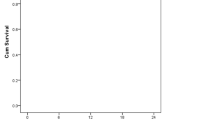Abstract
Purpose
Relationship between pathologic parameters, surgical parameters, or lymph node status with oncologic outcomes is not fully elucidated in endometrial cancer (EC). We want to investigate the molecular classification of uterine cancer in the Turkish population and its relationship between lymphadenectomy and lymph node metastasis.
Methods
In this study, 100 patients' clinical and pathologic data diagnosed with EC were analyzed. Pathologic and molecular parameters were investigated and compared them with clinical parameters.
Results
According to the molecular analysis, 16 patients (16%) had p53 mutation, 3 patients (3%) were classified as POLE mutant group, 38 (38%) patients in the MSI group, and the remaining 43 patients (43%) into the no specific mutation profile (NSMP) group. Lymph node metastasis rate was significantly higher in copy number high (CNH) group compared to the others. In the CNH group, 29 of 437 (6.6%) dissected lymph nodes had metastasis. The median OS was the highest in the POLE group (72 months) and lowest in the CNH group (36 months).
Conclusion
Endometrial cancer patients showed significantly different overall and disease-free survival according to the molecular subtypes and it was consistent with the literature, Lymph node metastasis risk was the highest in CNH group. MSI status is important for the lymph node metastasis risk but not all abnormalities, especially PMS2 and MLH1 expression changes showed the highest risk.


Similar content being viewed by others
References
(2020) Corpus uteri Source: Globocan 2020
Siegel RL, Miller KD, Jemal A (2020) Cancer statistics, 2020. CA Cancer J Clin 70:7–30. https://doi.org/10.3322/CAAC.21590
Alexa M, Hasenburg A, Battista MJ et al (2021) Cancers the TCGA molecular classification of endometrial cancer and ıts possible ımpact on adjuvant treatment decisions. https://doi.org/10.3390/cancers13061478
Talhouk A, McConechy MK, Leung S et al (2017) Confirmation of ProMisE: a simple, genomics-based clinical classifier for endometrial cancer. Cancer 123:802–813. https://doi.org/10.1002/CNCR.30496
Lé On-Castillo A, De Boer SM, Powell ME et al (2020) Molecular classification of the PORTEC-3 trial for high-risk endometrial cancer: impact on prognosis and benefit from adjuvant therapy. J Clin Oncol 38:3388–3397. https://doi.org/10.1200/JCO.20
Kommoss S, McConechy MK, Kommoss F et al (2018) Final validation of the ProMisE molecular classifier for endometrial carcinoma in a large population-based case series. Ann Oncol Off J Eur Soc Med Oncol 29:1180–1188. https://doi.org/10.1093/ANNONC/MDY058
Bidzinski M, Danska-Bidzinska A, Rychlik A, et al (2022) Molecular classification of endometrial carcinoma, is it the new era of precision medicine? Ginekol Pol 93:. https://doi.org/10.5603/GP.a2021.0216
Church DN, Stelloo E, Nout RA et al (2015) Prognostic significance of POLE proofreading mutations in endometrial cancer. JNCI J Natl Cancer Inst 107:402. https://doi.org/10.1093/jnci/dju402
Raffone A, Travaglino A, Raimondo D et al (2022) Lymphovascular space invasion in endometrial carcinoma: a prognostic factor independent from molecular signature. Gynecol Oncol 165:192–197. https://doi.org/10.1016/J.YGYNO.2022.01.013
Leon-Castillo A, Horeweg N, Peters EEM et al (2022) Prognostic relevance of the molecular classification in high-grade endometrial cancer for patients staged by lymphadenectomy and without adjuvant treatment. Gynecol Oncol 164:577–586. https://doi.org/10.1016/J.YGYNO.2022.01.007
Li X, Cheng Y, Dong Y et al (2021) Development and validation of predictive model for lymph node metastasis in endometrial cancer: a SEER analysis. Ann Transl Med 9:538–538. https://doi.org/10.21037/ATM-20-5034
Vargas R, Rauh-Hain JA, Clemmer J et al (2014) Tumor size, depth of invasion, and histologic grade as prognostic factors of lymph node involvement in endometrial cancer: a SEER analysis. Gynecol Oncol 133:216–220. https://doi.org/10.1016/J.YGYNO.2014.02.011
Okamoto K, Nakamura K, Haraga J, Masuyama H (2022) Molecular characteristics of metastatic lesions have superior prognostic ımpact on endometrial cancer. Anticancer Res 42:4535–4543. https://doi.org/10.21873/ANTICANRES.15956
Wang Z, Sun Y, Gao B et al (2014) Two co-existing germline mutations P53 V157D and PMS2 R20Q promote tumorigenesis in a familial cancer syndrome. Cancer Lett 342:36–42. https://doi.org/10.1016/J.CANLET.2013.08.032
Zhao L (2018) Mismatch repair protein expression in patients with stage II and III sporadic colorectal cancer. Oncol Lett 15:8053–8061. https://doi.org/10.3892/ol.2018.8337
Funding
For this study, we had a funding from the Afyonkarahisar Health and Science University scientific research project (BAP-20.genel 005/2020).
Author information
Authors and Affiliations
Corresponding author
Ethics declarations
Conflict of interest
We do not have conflict of interest.
Additional information
Publisher's Note
Springer Nature remains neutral with regard to jurisdictional claims in published maps and institutional affiliations.
Rights and permissions
Springer Nature or its licensor (e.g. a society or other partner) holds exclusive rights to this article under a publishing agreement with the author(s) or other rightsholder(s); author self-archiving of the accepted manuscript version of this article is solely governed by the terms of such publishing agreement and applicable law.
About this article
Cite this article
Bilir, F., Arıoz, D.T., Arıkan, S.E. et al. Relationship between molecular markers and lymphadenectomy and lymphovascular space invasion in endometrial cancer. Arch Gynecol Obstet 308, 941–946 (2023). https://doi.org/10.1007/s00404-023-07005-9
Received:
Accepted:
Published:
Issue Date:
DOI: https://doi.org/10.1007/s00404-023-07005-9




